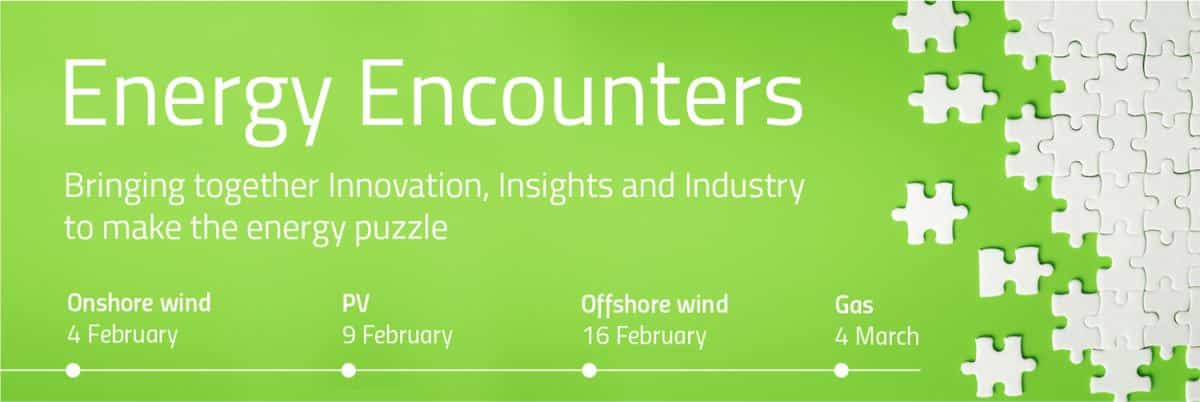Summary – Energy Encounters session “Gas”

The 4th session of EnergyVille’s Energy Encounters was dedicated to “gas” as energy source. This summary will guide you through the most important findings of the session.
As first speaker, Pieter Vingerhoets of VITO/EnergyVille, highlighted that gas currently plays an important role, supplying up to 30% of the final Belgian energy consumption in 2019. Gas is used for electricity production, for heating homes and in industry, either as a feedstock or as an energy carrier. It has multiple advantages. When looking specifically at electricity generation, the flexibility of the power plants using gas as primary energy source, is an asset, certainly in combination with renewables. Furthermore, we have a well-developed and strong gas transportation infrastructure present in Belgium with strong international links both by pipelines and LNG, and thirdly, it is possible to store gas in large quantities, for example in underground storage facilities. The main disadvantage of natural gas is its fossil nature and the emission of CO2 it causes.
An EnergyVille study conducted last year, illustrates how in a high renewable energy scenario for the Belgian electricity production, natural gas remains important in the twenties, but its impact will decline in the thirties. As more renewables are installed in Belgium and the neighbouring countries, the operational hours of gas power plants will decrease. At some point in time, if we aim for further levels of CO2 reduction, we need to look into low carbon gases. Several low carbon gases or liquid fuels exist, such as biogas and bio-methane, related to biomass sources. Then there is hydrogen, in various “colours” (grey, blue, turquoise and green), referring to the production process. Synthetic fuels include ammonia, methanol, synthetic methane and other synthetic hydrocarbons, all of them based on green hydrogen if they have to be carbon neutral. The hydrocarbons use CO2 sources from CCS from the industry or from energy intensive direct air capturing in future.
The focus on green hydrogen, also linked to the high ambition of the European Commission, raises the question whether we should start producing green hydrogen “en masse”, and whether we need to start using it to decarbonise the energy system. The EnergyVille study shows that even when the Belgian energy plans are executed and when the neighbouring countries install a high amount of renewables, there might not be enough excess electricity to operate a significant share of electrolysers (needed for the production of hydrogen). The biggest challenge for scaling up green hydrogen is a sufficient amount of low cost fossil free electricity during a substantial numbers of hours per year.
In priority perspective, synthetic fuels form the next step (after energy efficiency measures and circularity of materials, and electrification). It is more efficient to use electricity in a direct way, for example using the available electricity in a heat pump to generate domestic heating, instead of converting electricity to hydrogen, and then burn this for heating purposes. The same holds for electric vehicles compared to hydrogen alternatives. Evidently, there are cases where electrification is not sufficient, for example feedstock in the chemical industry, steel industry reduction agents, international aviation and navigation, and as a strategic back-up for longer periods without sun and wind.
Ending with a view on the bigger picture, Belgium is one of the key regions where hydrogen demand in industry will be high, which means that the import of energy (in the form of electricity or molecules) will be very important, with a lot of opportunities for our industry.
Yves Vercammen, Transformation Projects Director at FLUXYS, explained how Belgium is at the centre of the European natural gas grid. In addition, a considerable amount of import and export of natural gas is taking place, making Belgium the “plaque tournante” of Europe.
In the context of the energy transition, it is known that there is an intense energy demand in Belgium (420 TWh for all carriers, excluding bunker fuels for navigation and aviation), to a large extent coupled to fossil fuels emitting CO2. The future however, is carbon-neutral. In this regard, it is important to note that not all emissions are related to combustion and that a non-negligible part (16%) is related to processes. Therefore, changing the entry fuel does not always change the emissions. That is why it is also important to find solutions to capture that CO2.
The energy transition focused its efforts on energy efficiency first, and on renewable energy sources. The challenges however, are the increasing intermittency and the situation where there is neither wind nor sun for multiple days in a row. Then flexibility and storage come into play; on the short term this takes the form of demand side management, batteries and pumped hydro, on the longer term this encompasses molecules and strategic back-up volumes. The future energy system will need to comprise lots of different solutions, but will be characterised by the interplay between sustainability, security of supply and affordability. On the one hand, there will be massive amounts of green electrons and on the other hand massive amounts of green molecules. In this system, CO2 is no longer regarded as waste, but as the building blocks of fuels.
The carbon neutral molecules that will be present in the future gas system comprise biogas, biomethane and carbon neutral hydrogen. Looking at biomethane, there are several advantages: its compatibility with the natural gas network and the further infrastructure, the local aspect, the circularity and the system resilience it enables at a local level. The potential in Belgium is estimated at 10 to 15 TWh, which might seem rather limited. However, when regarded as flexible solution, it can certainly add value when needed and can be used for specific areas where it will be difficult to abate CO2. Concerning green hydrogen, it is stated that the potential in Belgium is challenging and that it will more likely be produced in other countries, where the availability of renewable electricity is much higher. Concerning blue hydrogen, opportunities exist, but they depend on the infrastructure to deal with CO2. An important part of that infrastructure, the carbon capture, is a key component of the future system, as the industry is producing CO2 – either by burning fossil fuels or as the outcome of processes – and needs to deal with that. In a first instance carbon capture and storage is looked into but ideally, it should be possible to re-use that CO2 and make fuels out of it and focus on re-use and circularity.
The momentum is here, the Green Deal is setting the framework, the EU Recovery Plan is adding funding opportunities and the industry is keen to lead the way. As such, Fluxys currently engages to make the existing gas network “future-proof”, with the ambition to optimally re-purpose the grid for the transport and storage of “green molecules”. In line with this strategy, it developed a “back-bone” concept both for H2 en CO2.
The encounter continued with interactive debate with following panelists:
- Yves Vercammen, Transformation Projects Director at FLUXYS
- Daniel Marenne, Energy Solution Architect Engie Generation Europe at ENGIE
- Floris Mackor, Managing Director Air Liquide Benelux Industries
- Peter Koninckx, Vice President Siemens Energy Belux
As in the previous sessions, Luc Pauwels (VRT) actively guided the discussion. The highlights of the debate can be summarised by the following key issues:
- What will be the role of gas-fired power plants in our net zero-carbon future and what fuels could be used to lower emissions?
- Supply should be secured, accounting for generation from renewable energy sources first, and supplementing with import, storage, and back-up. For the part storage (i.e. batteries) cannot deliver, dispatchable power is needed, which seems counterintuitive. However, the system needs to be balanced in order to be able to increase the input from renewables. Over time, it will be possible to make that part greener by using green molecules.
- There are several ways to reduce emissions: the first is to capture the CO2 from the power station. This would increase the price and the plant would need to run as a baseload to make it interesting. The back-up will be worth the investment, referring to the situation in Texas. Secondly, the gas could be made greener, e.g. through biogas or synthetic methane. Both could be stored and used when needed, allowing for more flexibility. The third option is to burn hydrogen, although the technology is still under investigation. In any case, it will be necessary to think about how to use the available molecules and how to set up the flexibility.
- Specifically, on burning hydrogen for electricity generation: the technology is being developed and is now tested. It is already possible today to mix some amount of hydrogen (around 30% of the volume, so around 10% of the energy content) into the natural gas network; the goal is to be able to burn 100% hydrogen by 2030. It is expected that major limitations will not come from the technology, but from the production and/or transport of the green hydrogen. We will have to import this from regions in and outside the EU.
- What does this imply for our import dependency?
- There is an opportunity to change our dependency to a certain degree. However, as the known limitations remain, i.e. spatial limitations, dense population, etc., large scale production of hydrogen will not be possible and also in the future, high imports will be necessary. A start has to be made today, making agreements with countries that will be producing the electricity for the molecules. Biomethane is a different story, as more is possible on a local scale. However, also in this domain, decisions need to be made (now).
- In which sectors and for which applications does the panel see potential for hydrogen (or e-molecules)?
- Aside from the power sector, there is potential for other sectors, such as industry, transport, etc., as well. In transport for example, it would make sense to use hydrogen (or e-fuels) as a fuel for trucks and shipping, as the alternatives for fossil fuels are limited. In industry, the challenges depend on the type of industry. For example, cement industry has a specific challenge as most of its CO2 emission result from a difficult to avoid calcination process. Steel industry is exploring different alternatives to produce CO2-neutral steel. Recycling of steel can be done more effectively in this sector. Another option to reduce carbon intensity in the steel sector is the combination of biomass replacing coal and the production of ethanol from the furnace gases.
- Considering heating of buildings, hydrogen is considered less efficient in terms of energy and costs. It is easier to transport electricity than hydrogen. It is possible to blend some hydrogen in the existing gas network, up to 2% without any problems for the infrastructures and the appliances of the users. As mentioned in the presentations before, it makes more sense to transport what is needed, instead of converting back and forth.
- What are essential requirements in EU gas legislation to enhance the role of green gas in the future?
- A serious problem is the double counting of CO2.
- Concerning carbon neutrality of the product: if steel is created with biogas, hydrogen and green electricity, it will be carbon-neutral while being more expensive. If there is no dedicated label to prove that, then there will be no market. What is needed is the right regulation recognising the carbon neutrality of products and a certified label, so the products can be sold at a higher price.
- There is the need to scale up to bring the costs down. A continued series of projects could help in this regard, to share the risk. The sector is at the stage where offshore wind was many years ago: it is proven to be possible, but it is still too expensive. Further regulatory work is needed and support schemes to make those first projects happen and get ahead of the (global) curve. ETS can also play a role here.
As a preliminary summary of the debate following 4 points were highlighted:
- Molecules are and will remain a key element of the energy system of the future. The different options are there (hydrogen, methane, ammonia, methanol, …) and the balance will also be a result of the international market development. Belgium needs to clarify its position now.
- Capturing, storage and reuse of CO2 will be an important part of the equation. The use of CO2 for synthetic fuels is a key element in the circularity of carbon.
- The molecules remain an international business, which flows in all directions. Investments have to be part of a global view.
- Industry has to adapt and go more and more to flexible processes, both for power generation and manufacturing processes (chemical, cement, steel, paper, …). Also molecule-based systems have to take this flexibility into account.







